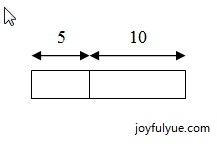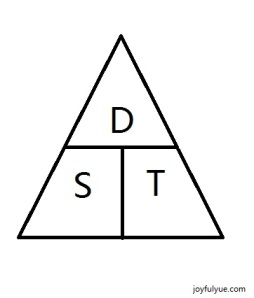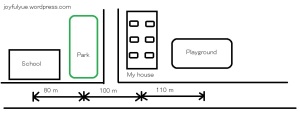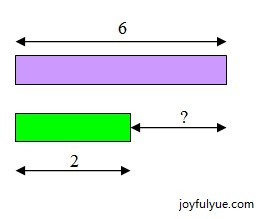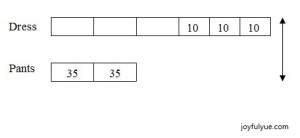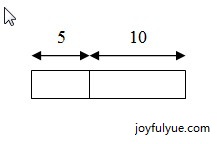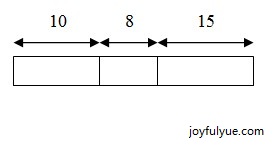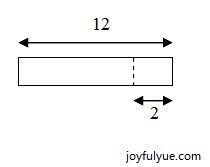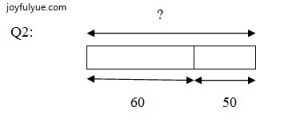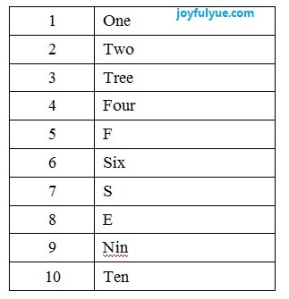Home » Mathematics
Category Archives: Mathematics
Counting Speed 2
Q: Jeff drives at the speed of 50 km/h from destination A to B. Jackson, who departs 30 minutes after Jeff, drives at the speed of 70 km/h from destination A to B. Both Jeff and Jackson reach destination B at the same time. What is the distance between destination A and destination B?
A: At first glance, the students may question whether there is an answer. Although the speed and the time are given, the time is not the time taken to travel from destination A to destination B.
No worry. The distance travelled is the same for Jeff and Jackson and we can use this information to solve the question. Please note that the unit for time is minute, converting to hour, it is 0.5 hour.
Let’s take t = time take for Jeff to reach destination B.
The distance travelled for Jeff = speed x time
= 50 x t
The distance travelled for Jackson = speed x time
= 70 x (t – 0.5)
The distance travelled is the same,
50t = 70 (t – 0.5)
Solving the above equation,
50t = 70t – 35
t = 35 ÷ 20
= 1.75 h
From the speed triangle, distance (travelled by Jeff) = speed x time
Distance = 50 x 1.75
= 87.5 km
Checking the answer
The distance from destination A to destination B is the same. Thus, the distance travelled by Jeff and Jackson should be the same.
Distance (travelled by Jackson) = speed x time,
Distance = 70 x 1.25
= 87.5 km
Note:
1. Look for all the necessary information in the question and use all of them.
2. Speed is a simple concept. Thus, questions about speed are normally combined with other concepts, for example, circles. Other than the speed formula and the unit conversion, the students must be prepared to use other concepts to solve speed questions.
Counting Speed 1
After the students learn time and length, the next concept they learn in Higher Primary school is speed. The length is equivalent to the distance travelled.
The formula is
Speed = Distance ÷ Time
To help the students to remember the formula, a speed triangle is taught, as below.
Taking the example from Counting Length, if I cycle to school at the speed of 15 km/h, how much time do I need to reach school?
From the speed triangle, time = distance ÷ speed
From the figure below, the distance between my house and the school is 180 m.
Please take note that the unit for speed is km/h and the unit for distance is m. Thus, the first step is to convert the two different units to the same unit.
1 km = 1000 m
15 km = 15 000 m
With speed = 15000 m/h and distance = 180 m,
Time = (180 ÷ 15000) h
= 0.012 h
= 0.72 min
= 43.2 sec
Speed is a simple concept, once the students remember the speed triangle (and the speed formula) and familiar with unit conversion, the answer is somewhere near 🙂
In our daily lives, we travel by cars and public transport. Use the speed concept in daily life and maybe the student can manage time better too. Enjoy your learning experience!
Note:
1. In Secondary school, the students will learn the term “velocity” in Physics, which is speed with a direction.
2. (a) Take note of the unit used. For distance, common units are km and m. For time, common units are hour, minute and second. The units used for distance and time determine the unit for speed.
(b) Be fluent with unit conversion for distance and time.
A Long Way to Spell Seven
He is seven years old, going on eight years old. He can spell “butterfly”, “caterpillar” and “computer”. By now, he should be able to spell the numbers from one to ten. Although children learn in different ways, but there is a “milestone” to reach for different stages. Unable to spell the numbers from one to ten at the age of seven is perceived as “slow in learning”. That is his school teacher’s perception. My task, as a home tutor, is to make sure he is able to keep up with other students of the same age.
* * * * * * * * * * * * * * * * * * * * * * * * * * * * * * * * * * * * * * * * * * * * * * * * * * * * * * *
I gave him a list of 37 numbers and he needed to spell the numbers in words.
“I do not know how to spell.”
“It’s ok. We learn together.”
“It is a long list.”
“It’s ok. We can do up to ten today and continue the rest next time.” (My initial plan was to complete the first fifteen numbers, but I wanted to keep him interested at the same time.)
And he started writing “One” and “Two”. It was a good start. I encouraged him to continue, but the next “number” I saw was “Tree”.
I told myself to hold whatever I wanted to say. It was too early to correct him. I asked him to continue. The next one is “Four”. See? He can do it!
5, 6 and 7. Sensing that the spelling was wrong, he erased the answers for 5 and 7. He stuck at 8. He seemed discouraged. He was waiting for my help. Just three more numbers to go, I wanted him to continue.
“Ten is easy. Why not you try to spell ten, then go to nine, then e-i-g-h-t?”
I spoke e-i-g-h-t in a slow manner, hoping that he was able to get the hints I gave him. Below is the first version of his answers:
Next, we went through the answers. I told him the difference between Tree and Three. I told him se-ven is made up of two syllables…
We proceeded to other lessons. I did not want him to think that he is bad in spelling.
If the boy were your child, what would be your reaction to the above list? Panic? The more panic he sees from your reaction, the more stress he has. For me, it is a good start, he knows he cannot spell, he knows what is the first alphabet for each number. The next step is to reinforce what he has learnt and at the same time build up his confidence.
It will be a long journey for him and me.


